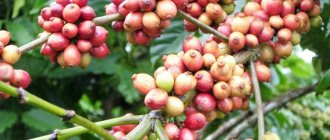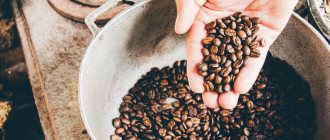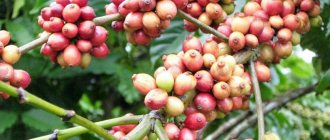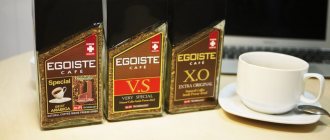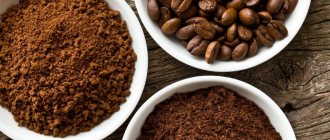Coffee varieties represent a wide and varied world of tastes and aromas, and what varieties there are will be discussed below, but first of all, it is worth learning about the four main types of beans, from which an invigorating drink is created.
Coffee has been one of the most popular and vibrant drinks all over the world since ancient times. It is appreciated by people of any age, and even a simple lover sometimes wants to know more about the drink.
Types of coffee
In total there are about 40 species of trees, and yet they vary greatly in external description. There are both shrubs and giants up to 7 meters high. But all types and varieties of coffee have been divided into four main groups, by which the type of drink is determined. So in the world it is customary to divide it into the following types:
- Arabica;
- Robusta;
- Liberica;
- Excelsa.
Each group has special properties, differences in grains and taste. It all depends on the place where the tree grows. The main factors of difference are soil and climate.
The main botanical varieties are Arabica and Robusta. They are the ones that are given special preference in the world. Liberica and Excelsa are too bitter in taste, so they are added only to mixtures of coffee beans to add an interesting bouquet.
There are also single-origin coffees. This is the name for varieties of the drink created from grains that were grown in one place, for example, only in Cuba or Brazil. In this way, manufacturers emphasize the special nature of their product.
Watch the video about monosort
Now it’s worth taking a closer look at each species.
Arabica
The most striking and widely sold type of coffee was and remains Arabica, accounting for more than half of all exports. It differs from all others in its mild taste and contains the least caffeine - about one and a half percent.
The drink comes out pleasant and has a slight aroma, and high-quality beans produce real aromatic Arabica beans.
The plant itself is capricious, but people value Arabica, which is grown only on high and warm mountain slopes. In a year, such a tree can produce up to five kilograms of harvest, but in its pure form it will produce only one kilogram of long, even grains suitable for sale.
It is interesting that from the Arabica guatemala species they obtain the Maragodzhip variety, whose beans are twice the size of all others.
Robusta
The unpretentious tree was first discovered in the Congo River area. This plant easily withstands temperature changes and depleted soil, while producing a large number of fruits. Also known as a fast-growing coffee variety.
Types of coffee drinks
The variety of coffee drinks is especially great. There are many methods for preparing coffee, each of which gives the drink a unique taste.
Classic
Black coffee . Coffee that is served immediately after brewing, without adding anything or changing the taste.
Coffee with sugar and/or milk. Black coffee to which cream, milk, sugar or artificial sweetener is added after preparation to enhance the taste.
Espresso. To prepare this drink, very finely ground coffee is used. A small amount of water is added, which affects the taste and strength of the drink.
Cooking methods
Cold coffee. During cooking, cold rather than hot water is used. Ice coffee takes a little longer to prepare than usual.
Drip (filtered) coffee. In this method, ground coffee is placed on a paper filter and then hot water is poured over it. The liquid drips into the container under the filter.
French press. This technique uses a French press. You need to lower the plunger so that the ground coffee remains at the bottom and does not fall into the mug.
Chilled coffee. This drink differs from cold drink in that it is prepared with hot water and then cooled.
Moka. This drink is prepared in a geyser coffee maker. In it, steam pressure forces hot water through ground coffee.
Coffee in a percolator. The operating principle of a percolator is based on the fact that hot water is filtered through ground coffee. This helps to achieve a high strength of the drink.
Cooking in a vacuum siphon. The siphon machine consists of two chambers. Coffee is brewed due to steam pressure and vacuum.
Espresso based drinks
Caffe Gommosa – espresso with one marshmallow.
Café Con Hielo – chilled version of espresso: 50 ml espresso served over ice.
Cortado is espresso with a small amount of warm milk, which reduces the acidity of the drink.
Doppio is a double shot of espresso served in a demitasse mug.
Espresso con panna – espresso with whipped cream.
Espresso Romano is espresso served with a slice of lemon.
Guillermo - two shots of espresso with lime slices, sometimes served with ice.
Lungo is the antonym of ristretto. A large volume of water is added to this drink.
Ristretto is espresso to which half the amount of water is added than usual.
Drinks with milk or water
Antoccino is a shot of espresso served with fresh milk in a 1:1 ratio.
Breve is an espresso to which equal parts milk and cream are added.
Americano is espresso to which hot water is added. The result is a drink that is similar in strength to regular drip coffee, but differs in taste.
Coffee with milk is strong coffee to which pasteurized milk is added in a 1:1 ratio.
Zorro is a double shot of espresso to which hot water is added in a 1:1 ratio.
Cappuccino – espresso with hot milk and milk foam.
Espressino is an espresso-based drink with the addition of steamed milk and cocoa powder.
Flat white is an espresso similar to a latte, but with textured milk added.
Latte is an espresso to which fresh milk is added in a ratio of 1:3 or 1:5, as well as a little milk foam.
Macchiato is espresso with a little frothed milk. The drink is similar to cappuccino, only macchiato is stronger.
Viennese coffee - espresso with whipped cream. Sometimes milk is added.
Drinks from all over the world
Black Tie is a double shot of espresso mixed with traditional Thai chilled coffee and sweetened condensed milk.
Bombon – espresso with condensed milk. The drink was popularized in Spain.
Cuban coffee - espresso with cane sugar. The drink first appeared in Cuba.
Caffe Creama is a lungo espresso served mainly in Switzerland, Austria, and northern Italy since the early 1980s.
Ca Phe Sua Da is a Vietnamese drink whose name literally means “chilled coffee.” Black coffee is mixed with condensed milk (a quarter or half the volume) and then poured into ice.
Egg coffee is a Vietnamese drink consisting of egg yolks, sugar, condensed milk and Robusta coffee.
Eiskaffe is a German drink consisting of chilled coffee and vanilla ice cream.
Gallon is a Portuguese drink consisting of espresso with steamed milk. Served in a tall glass.
Irish coffee – coffee with whiskey and cream. Sometimes sweetened with sugar.
Kopi susu – coffee with condensed milk. After preparation, the drink is left to cool, so the coffee particles fall to the bottom of the glass.
Turkish (Greek) coffee is a traditional Middle Eastern coffee drink. Finely ground coffee is immersed in water to produce the maximum amount of foam.
Special drinks
Bulletproof Coffee – 1 cup black coffee, 2 tablespoons oil, 1 tablespoon coconut oil. Everything is mixed until the mass reaches a creamy consistency.
Chai latte – espresso mixed with spiced tea and steamed milk.
Coffee with liqueur – coffee is mixed with a shot of liqueur (25 ml). Sometimes served with cream.
Mocha - latte with chocolate syrup.
Coffee varieties
This is not to say that the main varieties of coffee are grown only in one place. Different countries have their own characteristics for caring for trees, thanks to which the grains acquire their own special taste.
The list is very large, it is not even possible to say exactly how many varieties of coffee there are in the world; breeders are looking for new qualities for the plant every day. In addition, to determine the type, there is a strict classification based on grain size. The names and characteristics of the most famous are given below.
There are a great many varieties, but the leading positions are invariably occupied by the following varieties:
Brazilian bourbon santos
This is the most common type of coffee. Grown in Brazil, the bourbon has a chocolate flavor with a hint of almond and citrusy acidity. It is these qualities that give him high recognition in the world.
Maragogyp
This coffee variety is known not only for its sweetness, but also for the size of the beans grown, and the drink is thick and aromatic. The most famous plantations are located in Guatemala, Mexico and Brazil.
Medellin
The quality of the beans of this variety is on the lips of lovers every year. Careful collection and detailed sorting prevent bad seeds from being exported. Colombian producers carefully ensure that only even and smooth fruits are exported.
Colombia Excelso
The peculiarity of the variety will be a bright cocoa flavor and mild bitterness. There is a slight sourness.
Maracaibo
Venezuelan Maracaibo is not inferior in quality even to varieties from Colombia. Possessing notes of dry wine, it has no analogues throughout the world, which is highly prized at auctions.
Oksaka
The homeland of this variety is Mexico. The coffee has a well-defined flavor of vanilla and nuts, with a slight bitterness.
Antigua and Cobano
Both varieties are native to Guatemala. Many connoisseurs love their invigorating strength and pleasant sourness.
El Salvador Jalatenango
The floral aroma and almond flavor give the drink a certain sophistication. This is why the Brazilian variety is known throughout the world.
The origins of coffee culture
Coffee traditions began to emerge in the world from the moment the beans began to be supplied to Turkey. This period occurred during the reign of Suleiman the Magnificent. The Sultan appreciated the unsurpassed taste of roasted coffee fruits and fell in love with the hot drink. Coffee enjoyment has been brought to perfection. It was prepared and served by 40 servants according to a special recipe.
In Europe, Turkish coffee culture did not fully take root, so its own unique tradition began to emerge. One thing remained unchanged - coffee should be drunk from small cups. It should be strong and scalding hot.
It was not the desire of ordinary people to drink a bitter drink that led to the addition of milk and sugar to it. Coffee shop owners were constantly experimenting and looking for their own unique recipes. This is how cappuccino, latte, and iced glass appeared.
At the beginning of the twentieth century, the Italian Bezzera came up with a unique espresso machine. Necessity drove him to invention. His coffee shop did not bring much profit, since it took a lot of time to prepare one serving. The establishment's employees leisurely brewed the drink and chatted with visitors along the way, but no one pays money for conversations. After the introduction of new technology, the situation changed - both sides began to save time. This device has taken coffee drinking culture to a new level.
Growing regions
The main coffee growing areas remain Brazil and Colombia, as well as many Asian countries and Africa. In the first two, wide coffee plantations are most often found, mainly Arabica trees.
But in India and Vietnam, other coffee trees are grown, such as Robusta and Excelsa. Italy is famous as a country for producing ready-made espresso drinks, which are distinguished by their special strength and unforgettable aftertaste.
Coffee production in Ethiopia
Despite the origins of coffee cultivation in Ethiopia, the country produced only small quantities for export until the 20th century, and much of it not from the south of the country, but from the area around Harar in the northeast.
It is estimated that in the 1880s, the Kaffa province where the plants were located produced between 50,000 and 60,000 kg of coffee beans.
Commercial production actually began in 1907 with the establishment of the inland port of Gambela.
100,000 kg of coffee were exported from Gambela in 1908, while more than 4 million kg passed through the port in 1927–1928.
At the same time, coffee plantations were established in Arsi province, which were eventually exported via the Addis Ababa-Djibouti railway.
Although only 245,000 kilograms were transported by rail, this amount grew to 2,240,000 kilograms by 1922, surpassing Harari coffee exports by 1925, and reaching 9,260,000 kilograms in 1936.
coffee makers from the coffee museum in Italy
Elite and rare coffees
The price of elite coffees is always very high, and they are also quite rare guests on supermarket shelves. On the global coffee market you can most often see:
- World number one Blue Mountain from Java;
- Indonesia's best coffee, Old Java, whose beans are aged for several years;
- Kopi Luwak with its exclusive production by passing through the intestinal tract of the small animal Musang;
- The highest grade of Galapagos San Cristobal coffee, harvested on the Galapagos Islands, where the trees are irrigated with the purest spring water from local lagoons.
Taste characteristics
Ethiopian coffee has a bright fruity-floral aroma, pronounced sourness, and a complex bouquet. It makes a light to medium-bodied drink.
The taste is largely determined by the method of processing coffee cherries. In Ethiopia they use both:
- Wet: the fruit pulp is removed immediately after picking the berries with plenty of water. The remaining fibers undergo a short fermentation and are also washed off. These grains have a bright, complex and very clean taste.
- Dry (aka “natural”). The fruits are dried in the sun and the pulp is removed before export or roasting. Such grains acquire more berry and chocolate tones, the drink turns out sweetish, as if a little syrup was added to it.
The dry processing method is much cheaper, so it is used more often in Ethiopia.
Why does coffee sour?
Sometimes a prepared drink has a sour taste, and an unprepared person may think that it is spoiled, which is completely wrong. He probably just hasn’t come across the concept of sourness in coffee yet.
This is a mandatory property of all Arabica beans: the higher the trees grow, the more sour the drink from the beans will be. Robusta does not have this quality.
In addition, the taste of the drink depends on the degree of roasting. If the beans are lightly roasted, then the coffee will definitely be sour, and if the beans have acquired a black tint, then in most cases it will not be sour, but will rather be bitter.
Ethiopian legend of the shepherd Kaldim
The history of the discovery of coffee is full of legends. One of the most popular is the story of the observant shepherd Kaldim.
A shepherd from Kaffa grazed a flock of goats every day. One day he drew attention to the fact that after eating red grains, they became excessively cheerful and active. This observation aroused his interest, and he shared his conclusions with the abbot of the monastery. He, in turn, decided to try the tonic properties of the plant on the monks, who kept falling asleep during prayers. Eating grains raw was not very tasty or pleasant, so they began to brew them. This is how the first coffee appeared.
A lot of time passed before the optimal option for preparing a tonic drink was selected.
Organic coffee
Organic coffee is perhaps one of the healthiest drinks available and is grown without the use of chemical additives or external soil amendments.
Naturally, it still contains caffeine, which is harmful to the body, but if you use moderation, organic coffee only improves the functioning of the digestive tract and cardiovascular system. They create organics from Arabica and Robusta.
The world of coffee is very wide and diverse; even a connoisseur sometimes does not immediately understand the numerous types of this noble drink. But at the same time, coffee is worth knowing and loving, because it contains all the taste of hot southern countries and high fertile mountains.
Legends about the history of coffee
Another version of the story about coffee and its origins credits this discovery to a Yemeni shepherd named Kaldi, who, around 1400 (or in another version, around 500 AD), watched as his goats tasted these mysterious berries, suddenly became hyperactive.
Concerned about this behavior, he told the story to some religious ministers who, by studying and reflecting on it, realized the potential of the coffee plant.
How the Arab world discovered coffee
Interesting Facts
Kopi Luwak coffee , produced in Indonesia. Oddly enough, the main player in obtaining the final product is the palm civet or musang. These animals eat fresh coffee berries, which are then digested in their gastrointestinal tract. Then the grains that naturally leave the civet’s body are dried in the sun, washed, dried again and fried. The high cost of Luwak coffee is explained by the fact that 1 kilogram of fresh beans yields only 50 grams of coffee.
The most popular drink in the world is espresso coffee.
Arabica is the most common coffee in the world. But British scientists say that by the end of the century, Arabian coffee trees may completely disappear from the face of the earth.
But it is impossible to say which type of coffee is the most delicious, since each of them has a unique aroma, taste, bouquet, and each of them finds its adherents. In addition, the taste of coffee can also be affected by the method of its preparation. At the same time, it is important to know not only how to brew coffee correctly, but also how to choose a coffee machine or Turkish coffee machine for home.
Cost and reviews
Those who go on a tourist trip to Ethiopia should definitely bring coffee back from their trip. Moreover, in local markets it is sold at a price of 80-90 birr per 1 kg (about 150 rubles).
Attention! Tourists should be aware that the country's laws prohibit the export of unprocessed grains. Therefore, you need to buy only fried product.
For comparison, in Moscow a kilogram package of Ethiopian coffee will cost from 2 to 4 thousand rubles, depending on the variety. According to customer reviews, Ethiopian coffee has some of the highest ratings. Its popularity is due to the combination of exquisite taste, subtle aftertaste and delicate aroma.
Types of coffee trees and their characteristics
Coffee trees are quite difficult to classify due to their wide variety. These can be 10-meter giants or very small dwarf shrubs. However, it is customary to distinguish 4 types of coffee trees:
- Arabica (Coffea Arabica) or Arabian coffee;
- Robusta (Coffea Canephora) or Congolese coffee;
- Liberica (Coffea Liberica);
- Excelsa (Coffea Dewevrei) or high coffee.
It should be noted that Arabica (70% of the world market) and Robusta (30%) are produced on a global scale. The remaining two types, similar in taste to robusta, are still not nearly as pleasant to the taste. Liberica finds its use only as mixtures in order to give the drink strength. But Excels has no economic significance at all.
Thus, what manufacturers write on the label is the type of plant, but in no case the variety. The only exceptions may be elite coffee varieties. This is important to know.
There are a great many varieties of coffee, more than two thousand. But coffee is extremely reluctant to be selected. Therefore, even if it is possible to cross several varieties of coffee and get a good harvest, its taste often suffers.
The variety is rarely indicated on the packaging, since in most cases coffee blends are used, which allows you to play with the taste and aroma of coffee.
Comparative characteristics of the main types of coffee are presented in the table.
| Arabica | Robusta | |
| Motherland | Ethiopia | Central Africa |
| Tree height | 3-8 meters | Up to 13 meters |
| Seeds | Plano-convex, elongated, with flat sides facing each other, the longitudinal groove is clearly defined | Small, round, have two small spots on either side of the groove |
| Growing height | 600-2500 meters above sea level | 200-900 meters above sea level |
| Desired temperature | +15 to +24 OS | From +24 to +30 OS |
| Required precipitation level | 1500-2000 mm | Withstands more than 3000 mm |
| Resistance to diseases, pests, frosts | Unstable | Stable |
| Reproduction | Grains | Cuttings |
| Productivity | Lower | Higher |
| Aroma | Tender, sour | Rich, rough |
| Caffeine content | Low | High |
| Fruit composition | Aromatic oils (18%); caffeine (1-1.5%). | Fragrance oils (8%), caffeine (3%) |
| Taste of coffee | Sweet, slightly sour, refined, less astringent | Stronger, astringent, rougher |
| Production cost | High | Low |
| Usage | As single varieties and in mixtures | For adding to mixtures and for the production of instant coffee |
Thus, for lovers of a strong, rich, bitter taste of coffee, varieties such as Robusta are perfect. Those who value a delicate aroma and pleasant taste in coffee should give preference to Arabica. Although some manufacturers mix these two types of coffee very skillfully.

